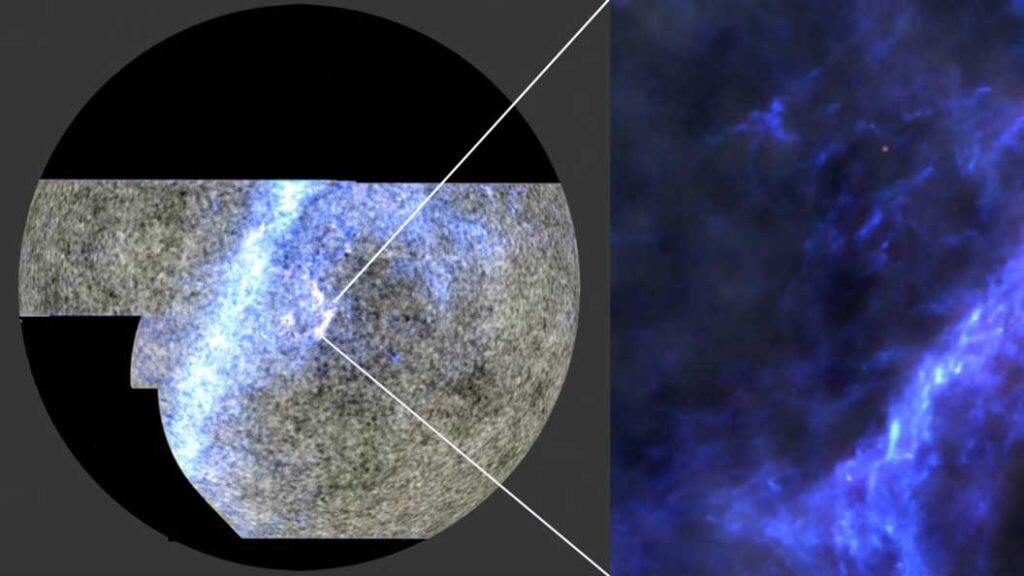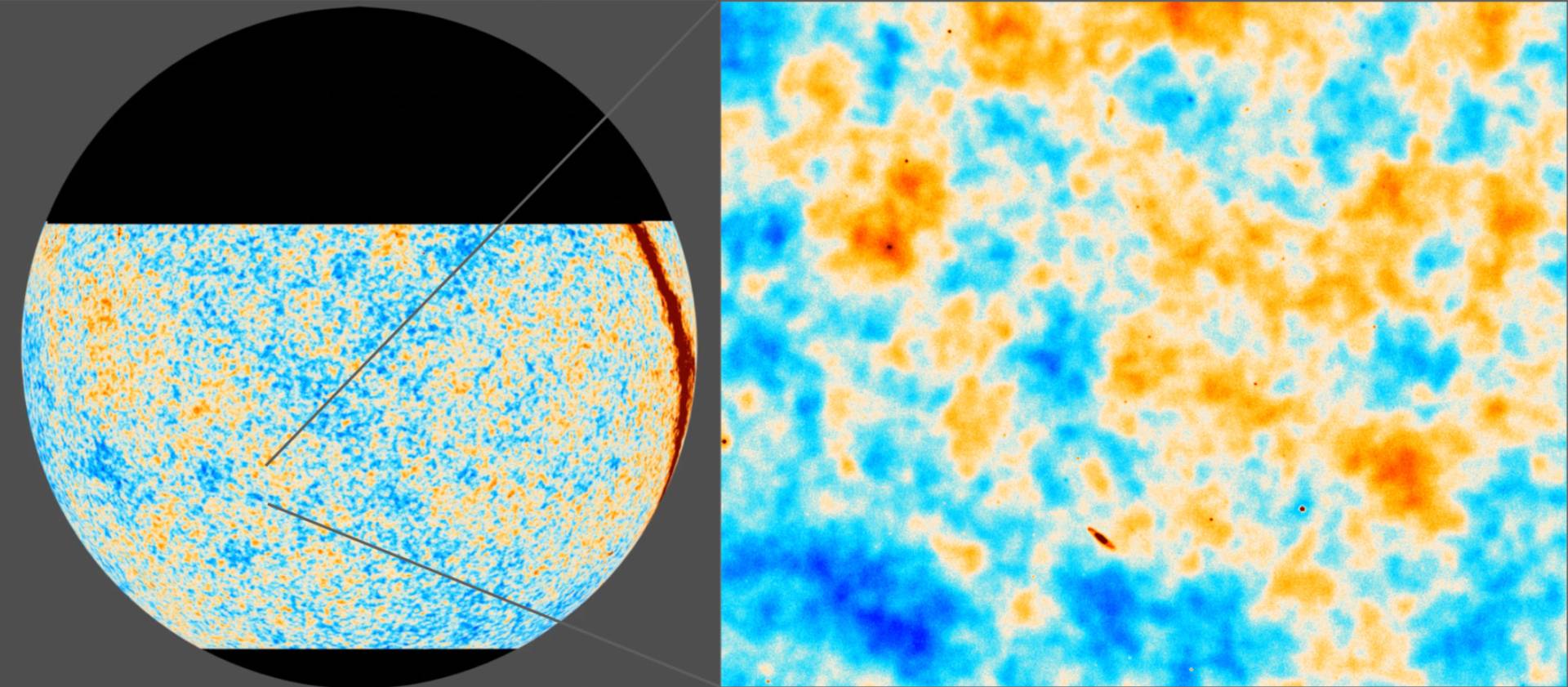New research by the Atacama Cosmology Telescope (ACT) collaboration has produced the clearest images yet of the universe’s infancy — the earliest cosmic time yet accessible to humans. The researchers released the images today and will present their results at the American Physical Society annual conference tomorrow.


Image from ACT Collaboration
Measuring light that traveled for more than 13 billion years to reach a telescope high in the Chilean Andes, the new images reveal the universe when it was about 380,000 years old — the equivalent of hours-old baby pictures of a now middle-aged cosmos.
“We are seeing the first steps towards making the earliest stars and galaxies,” said Suzanne Staggs, director of ACT and Henry deWolf Smyth Professor of Physics at Princeton University. “And we’re not just seeing light and dark, we’re seeing the polarization of light in high resolution. That is a defining factor distinguishing ACT.”


The colored band in this illustration shows the time period in the history of the universe that the new images capture.Diagram by Lucy Reading Ikkanda, Simons Foundation
The new pictures of this background radiation, known as the cosmic microwave background (CMB), add higher definition to those observed more than a decade ago by the Planck space-based telescope. “ACT has five times the resolution of Planck, and greater sensitivity,” said Sigurd Naess, a a researcher at the University of Oslo and former visiting researcher at Princeton who is a lead author of one of several papers to be presented along with the images. “This means the faint polarization signal is now directly visible.”
The polarization image reveals the detailed movement of the hydrogen and helium gas in the cosmic infancy. “Before, we got to see where things were, and now we also see how they’re moving,” said Staggs. “Like using tides to infer the presence of the moon, the movement tracked by the light’s polarization tells us how strong the pull of gravity was in different parts of space.”


A new image of cosmic microwave background radiation (half-sky image at left, closeup at right) adds high definition from the Atacama Cosmology Telescope to an earlier image from the Planck satellite. Orange and blue represent more or less intense radiation, revealing new features in the density of the universe. The Milky Way appears as a red band in the half-sky view. Image from ACT Collaboration; ESA/Planck Collaboration
In the first several hundred thousand years after the Big Bang, the primordial plasma that filled the universe was so hot that light couldn’t propagate freely, making the universe effectively opaque. The CMB represents the first stage in the universe’s history that we can see.
The new images give a remarkably clear view of very subtle variations in the density and velocity of the gases that filled the young universe. What look like hazy clouds in the light’s intensity are more and less dense regions in a sea of hydrogen and helium — hills and valleys that extend millions of light years across. Over the following millions to billions of years, gravity pulled the denser regions of gas inward to build stars and galaxies.
These detailed images of the newborn universe are helping scientists to answer long-standing questions about the universe’s origins. “By looking back to that time when things were much simpler, we can piece together the story of how our universe evolved to the rich and complex place we find ourselves in today,” said Jo Dunkley, the Joseph Henry Professor of Physics and Astrophysical Sciences at Princeton University and the ACT analysis leader.
“We’ve measured more precisely that the observable universe extends almost 50 billion light-years in all directions from us and contains as much mass as 1,900 ‘zetta-suns,’ or almost 2 trillion trillion suns,” said Erminia Calabrese, professor of astrophysics at Cardiff University, a former Spitzer Postdoctoral Fellow at Princeton and a lead author on one of the new papers being presented at the conference. Of those 1,900 zetta-suns, the mass of normal matter — the kind we can see and measure — makes up only 100. Another 500 zetta-suns of mass are mysterious dark matter, and the equivalent of 1,300 are the dominating vacuum energy (also called dark energy) of empty space.


The Atacama Cosmology Telescope (ACT), located high in the Chilean Andes, measures light that traveled for more than 13 billion years to reach Earth, peering back in time to the universe’s infancy.Photo by Debra Kellner
National Science Foundation funding for ACT started in 2004, at which time the principal investigator was Lyman Page, the James S. McDonnell Distinguished University Professor of Physics at Princeton, and the analysis leader was David Spergel, Princeton’s Charles A. Young Professor of Astronomy on the Class of 1897 Foundation, Emeritus.
“Our standard model of cosmology has just undergone its most stringent set of tests. The results are in and it looks very healthy,” said Spergel. “We have tested it for new physics in many different ways and don’t see evidence for any novelties.”
“Through their sweeping breadth, depth and attention to detail, the latest ACT results are a testament to the surprising durability of the standard model of cosmology and to the power of the CMB measurements to probe everything from the birth of the universe to stellar outbursts,” said Page. “The results are also a testament to a great team and to the National Science Foundation who made it all possible.”
In surveying the sky, ACT has also seen light emitted from other objects in space. “We can see right back through cosmic history,” said Dunkley, “from our own Milky Way, out past distant galaxies hosting vast black holes, and huge galaxy clusters, all the way to that time of infancy.”
ACT completed its observations in 2022, and attention is now turning to the new, more capable Simons Observatory at the same location in Chile. ACT shares data publicly on NASA’s LAMBDA archive.
The images and pre-peer review articles are slated to appear on the open-access arXiv.org(Link is external). They have been submitted to the Journal of Cosmology and Astroparticle Physics. In addition to the authors mentioned, lead authors include Zachary Atkins* (Princeton University), Yilun Guan (University of Toronto), Hidde Jense (Cardiff University), Adrien La Posta (University of Oxford), Matthew Hasselfield (Flatiron Institute) and Yuhan Wang (Cornell University).
*Atkins, a 2016 graduate of Princeton University who anticipates completing his Ph.D. from Princeton this spring, is presenting these findings and images at the American Physical Society annual conference tomorrow.
This research was supported by the U.S. National Science Foundation (AST-0408698, AST-0965625 and AST-1440226 for the ACT project, as well as awards PHY-0355328, PHY-0855887 and PHY-1214379), Princeton University, the University of Pennsylvania, and a Canada Foundation for Innovation award. The project is led by Princeton University and the University of Pennsylvania, with 160 collaborators at 65 institutions. ACT operated in Chile from 2007 to 2022 under an agreement with the University of Chile, in the Atacama Astronomical Park.






































